Click on images or Charmouth Home to return back.
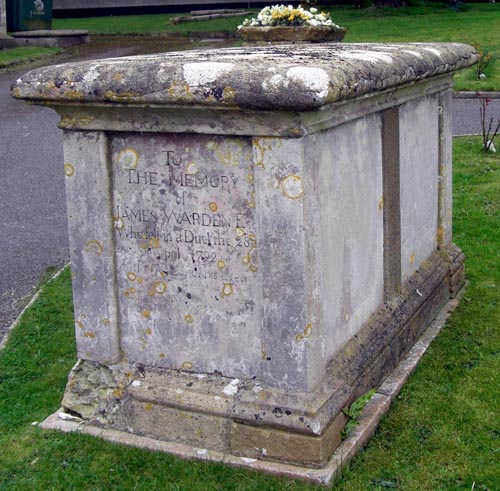
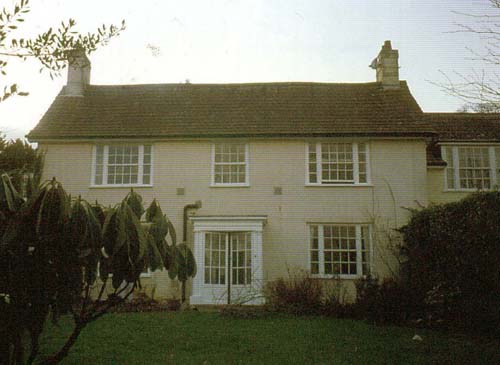

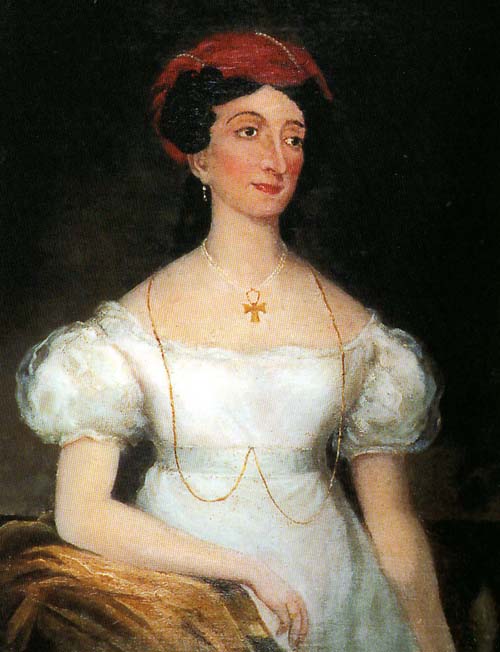
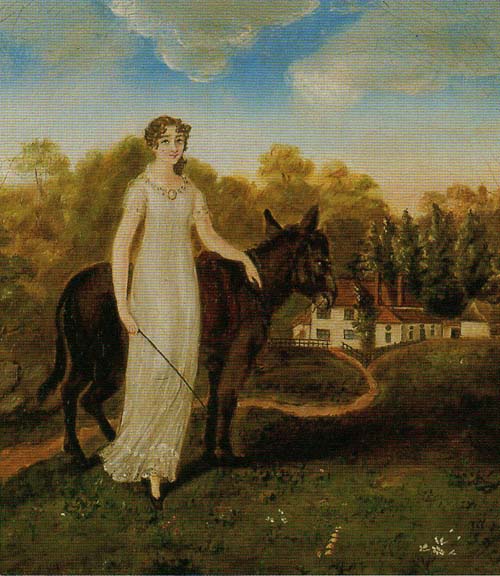
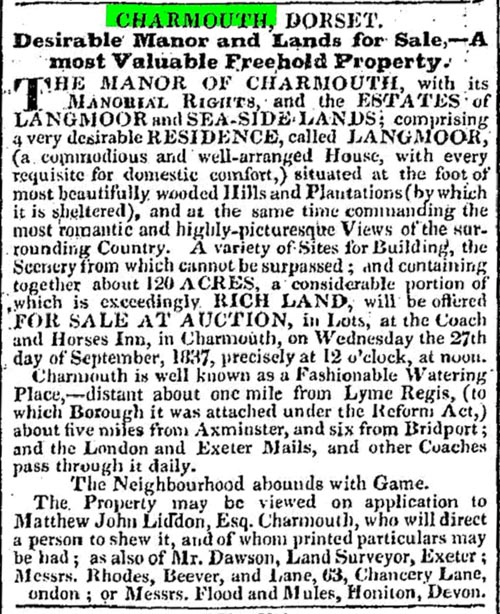
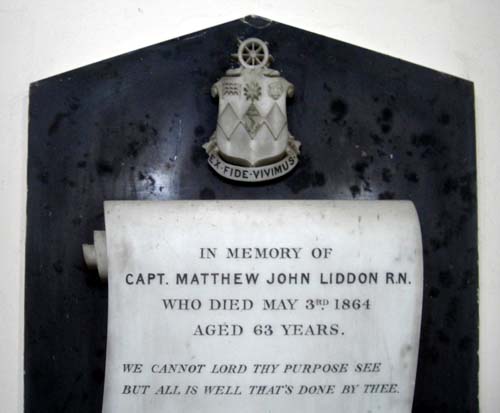
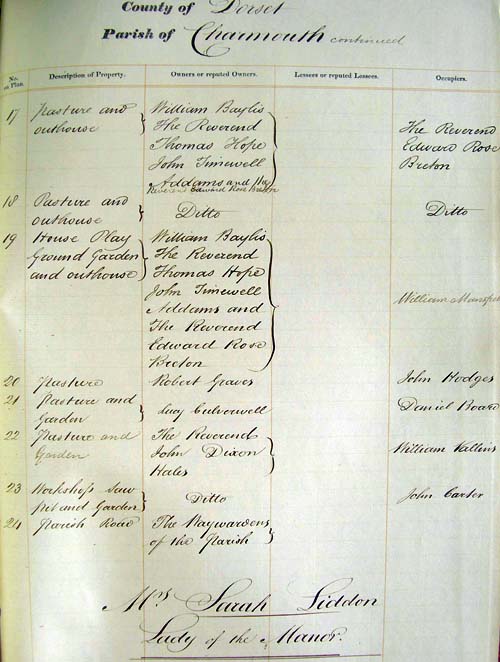
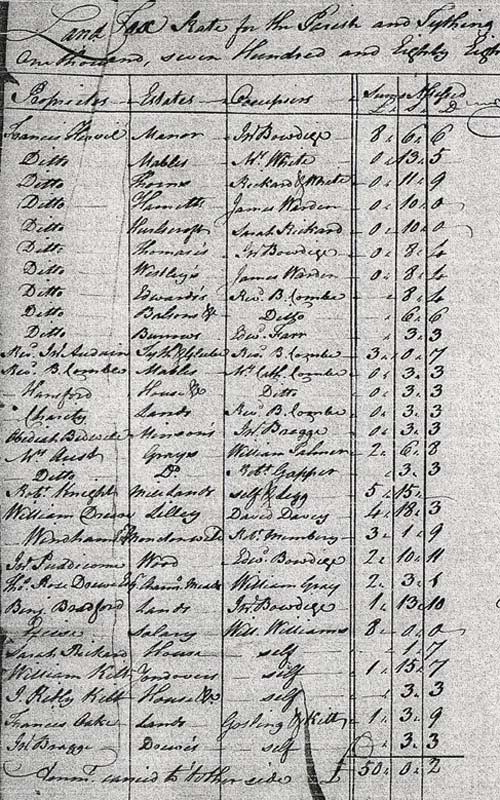
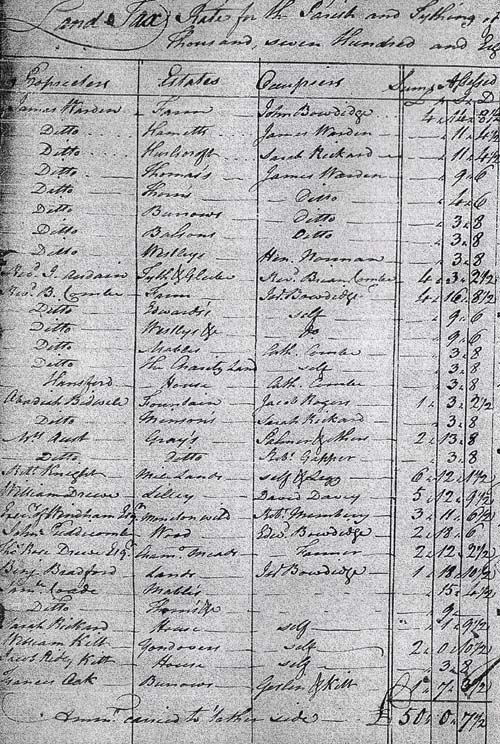
notice that the rates for The manor Farm have been halved as the Rev. Brian Coombes as prchased part of it from the Henvill Estate in 1788
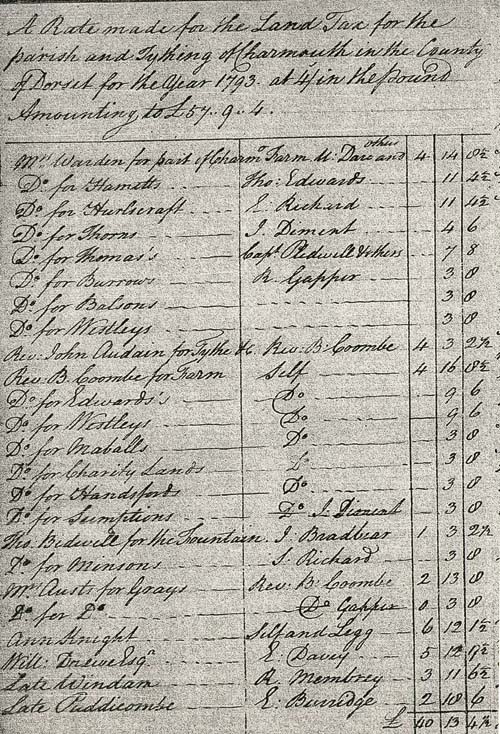


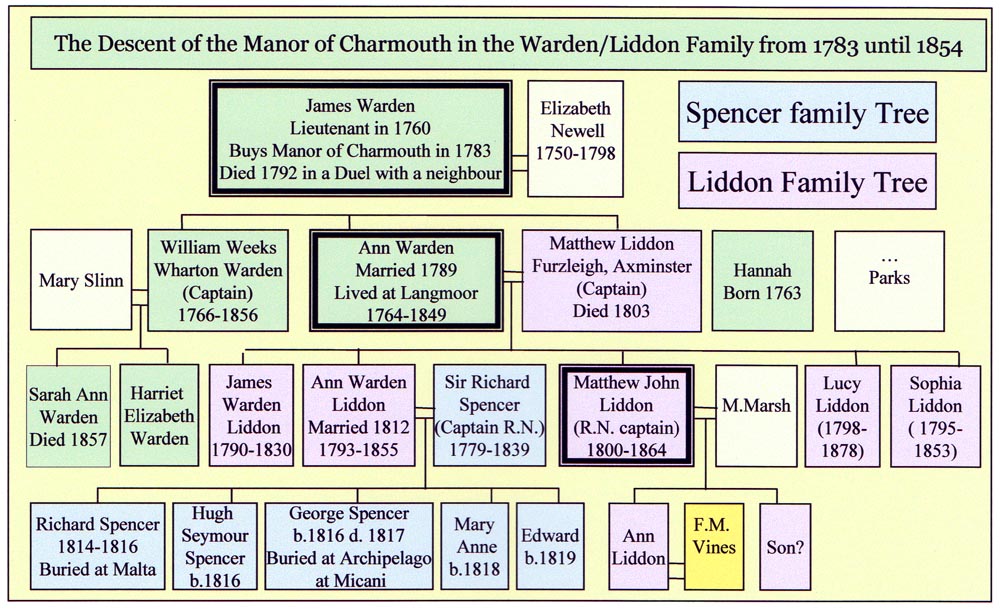
The Warden /Liddon Family 1783-1854
After the long association of the Ellesdon/Henvill family with Charmouth, another family was to take their position as Lords of The Manor, a number of whom were officers in the Royal Navy.
James Warden ( died 1792)
In 1783 on the death of Francis Phipps Henvill, the Manor of Charmouth was purchased by Lieut. James Warden R.N. If Warden occupied the Manor House, opposite the church, it cannot have been for long as he went to live at Langmoor and the Manor house- but not the manorial rights - was purchased by Simeon Bullen who died, in 1822. In 1852 John Bullen, his son, was owner and in his will of that date left the western end of his three houses to his great nephew John Bullen Symes, who added Bullen to his name and became known as Colonel Bullen. He believed that the house had originally was castellated from a depiction in a print now lost.
It is a puzzle how James Warden was able to afford Charmouth and also Langmoor Manor where he resided. It has been conjectured that it was from prize money for the nineteen Sea Battles he fought in. But the Will for his wife shows them owning considerable property at Wapping, near London.
He quarrelled with his son, whom he disinherited, and in his will left the Estate to his wife and upon her decease, upon trust, out of the rents and profits they were to pay to his son, William Weeks Wharton, £20 a year during his life by 4 evenly quarterly payments. But in case he should at any time sell, dispose of, or make away with or borrow money upon the said annuity. Then declared the bequest therof should be deemed void. The trust money was derived from Charmouth House property and other houses. It is interesting to see that the son was to live a long life and is still shown as living in his house in Charmouth when the Manor of Charmouth comes up for auction in 1854.
In 1789 James won an action against the Rev. Brian Combe and others for removing sand and seaweed from the beach.
His arguments climaxed with a disagreement with a neighbour, Norman Bond that resulted in a duel at Hunter's Lodge Inn with James being shot through the heart and the neighbour fleeing the country to Barbados. The episode is recorded on the large tabletop tomb near the entrance to Charmouth Church. His Wife, Elizabeth, was to survive him by 7 years, but not it would seem broken hearted. For a letter turned up where the writer says that:
“Mrs, Warden welcomed and even courted her widowhood. She chose the pistols, thanked the gentleman who had lent them and made no effort to prevent the duel, although she lived close to a magistrate. In short she seemed determined that one of them should fall. If Mr, Bond, that her husband must be hanged, and if the latter, she was fairly rid of him”. She was to lease Langmoor to a Mr Dicken and move to Axminster where she was to spend her last years.
Ann Liddon, nee`Warden ( 1764- 1849)
James and Elizabeth Warden were to have three children. The eldest Captain William Weeks Wharton Warden lived most of his 90 years in Charmouth receiving just £20 a year as his inheritance. It was his sister Ann who was to become Lady of the Manor on the death of her mother in 1798. She had married Matthew Liddon by licence in Axminster on 22 June 1789 in the presence of her father, the ill-fated James Warden. At least five children were born of the marriage, Elizabeth in 1791, Sophia in 1793, Ann in 1795, Lucy in 1799 and Matthew John in 1801. The Liddon`s were an important family in Axminster, where they are shown as Farmers and Clothiers. She was living at Langmoor when she died in 1849. Her name appears as Lady of the Manor in the detailed plans Isambard Kingdom Brunel drew up in 1846 with a proposal for a Railway linking Exeter, Yeovil and Dorchester with a branch and Station to Charmouth (Devon Record Office, QS/DP/210 1846). The land Tax the following year shows her renting to John Hodges and others her various properties and fields. The 1841 Census and Tithe Map show her living with her two of her daughters in Charmouth. Her eldest son was to die young at just forty and most of her Estate went to younger son, Matthew. It is of interests that her eldest daughter Ann Warden Liddon was to be one of the earliest emigrants to Australia when she left these shores in 1833 with her nine children. By then she was Lady Spencer and accompanying her husband Captain Sir Richard Spencer, he was taking up his appointment of Government Resident at Albany.
At the time of Ann's marriage in 1812 to Captain Richard Spencer, a distinguished post captain in the Royal Navy, at St Matthew's Church, Charmouth, they were possibly living at Langmoor Manor. She was seventeen years old and Richard Spencer was thirty-three. Ann's marriage portion was £2,000, a sizeable sum for those days and when her husband died in 1839, this amount was still intact.
A remark made by Reginald Pavey concerning the subsequent ownership by James Warden`s daughter has baffled me for ages. In his notes he refers to her being in debt and having to mortgage the Manor to pay for his children's education. Without any evidence I thought it best just to mention it in passing. But I was delighted to find buried in the Dorset Record Office a magnificent bundle of deeds that covered the Liddon`s ownership and revealed the tangled web of debt she and her family were to amass on the security of the Manor of Charmouth for over 50 years. It was not where I had expected to find them, but in later owners Abstract of Title, which had been copied in depth by his solicitor. It is a fascinating record of how the family held on to the Manor and used it to settle School fees, Marriage Settlements and upkeep with only having to sell off properties occasionally. Villages were annually paying their rents unaware as to whom their payments were going to. Initially Ann Liddon (nee`Warden) on the early death of her husband Matthew in 1804 had borrowed £600 from Samuel Newberry, a wealthy gentleman shown as living ay Bovey House in Beer. She later had to borrow a further £555 from C.Flood and S. Miles, which the document shows, was needed to “ better educate and support her children in a suitable manner”.
The year 1812 was to prove an expensive year for Anne when she had to find the settlement for the marriage of her daughter Ann Warden Liddon to Richard Spencer. She was to sell some of her Charmouth properties and take out another loan. This time the Rev. Charles Forward of Axmister was to assist her in meeting her debts. By 1821 her creditors wanted payment, as she had not paid any interest on the loan. She was fortunate to borrow £1500 from Sarah Northcote using the security of Charmouth Manor to pay off the other creditors and merge her debts. Sarah was to die in 1838 and leave everything to her brother George Barons Northcote. When Ann died in 1849 her surviving children are shown as Mathew Liddon, Jnr, of Harwich, Essex, a Lieutenant in the Royal Navy, Sophia Jackson Liddon and Lucy Liddon. In her will she leaves each of them a part of the Manor of Charmouth. Thomas Russell, an Attorney in Beaminster is now shown as the main creditor after paying off the other parties. Her daughter Ann had by now become Lady Spencer and resided in King Georges Sound, Albany in Western Australia.
Her husband Sir Richard had a colourful career in the Royal Navy and served under Lord Nelson and had been involved in a number of skirmishes. He was appointed by Nelson to command the captured French schooner Renard , which was renamed Crafty ; in her for five lively years and had many adventures including rescuing thirty Maltese captives who rewarded him with a hundred-guinea set of silver plate which is still in the families possesion. He suffered severe head wounds in action against two Spanish ships, and once swam Valetta harbour to save his ship from destruction.Early in 1808, he was appointed commander of the corvette Samarang on the East Indies Station, where his service in the subjection of Amboina and adjacent islands were to be rewarded with substantial prize money for his actions and also brought promotion to command the Blanche , in 1812. Soon afterwards he went on half pay until June 1815 when he was appointed captain of the Eurydice . In that year he was also unexpectedly knighted for his services to the country. When his naval career ended in 1817 he went to live in Lyme Regis near the Cobb during which nine of their ten children were born. But concerned about the future employment of both him and his children he decided to emigrate to Australia in 1833 where he was appointed Government resident of Albany. He made a great success of his time there and transformed the economy of this small town. At the same time he bought a farm called Strawberry Hill, which he greatly extended. Sadly he was to die suddenly in 1839 and his wife remained to bring up their large family. In 1851 she decided to pass her interest in the manor of Charmouth to her brother Matthew. Two years later his sister, Sophia died and he received her share. He also was to borrow a further £150 at 4% interest per annum from Thomas Russell. Finally in 1854 the Manor was put up for sale in an Auction in London and was bought by a wealthy Corn Merchant, George Frean of Plymouth. The proceeds from which went to Matthew and his sister Lucy Liddon.
Matthew Liddon (1800- 1864)
The Naval Records for Matthew held at the Public Record Office are quite informative and show him rising from Masters Mate in 1822 to Lieutenant in 1828. He retired in 1860. At the time of his mother's death he had a house called “The Grove” in Axminster . Shortly afterwards in 1854 he put the Estate up for sale. The Sale particulars describe a valuable Compact Estate comprising the Manor of Charmouth with all its rights and also Langmoor House with its park. The Auction was held by H.Brown & T.A. Roberts at the Auction Mart, opposite the Bank of England. A newspaper advert for 1862 show him still owning property in the village when he sells by auction, "a pleasantly situated and roomy freehold dwelling house formerly called Streets Tenement with an excellent large garden and orchard situated opposite- Lower Sea Lane." This house was no doubt “The Limes” or as it is now known “Charmouth Lodge” in the Street. Matthew was to die in 1864 leaving two children, but by then their links with the village had been broken and the Manor of Charmouth had long been out of the family's hands. There is an unusual marble memorial to him in the church with a coat of arms above the inscription.
On 2nd September 1944 Prudence F. Liddon Tosetti was born, and christened in Charmouth church on 15th October the same year. She was the great great grand daughter of Captain, Matthew Liddon, grandson of James Warden and niece of Harry Liddon RAF killed in action on 5th May 1943 whose name is on our War Memorial.